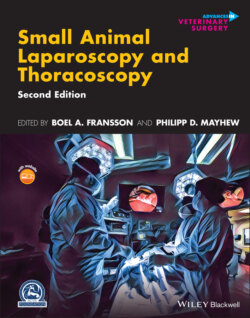Читать книгу Small Animal Laparoscopy and Thoracoscopy - Группа авторов - Страница 55
Needle Introduction
ОглавлениеThe needle introduction method used depends on the type and size of needle, the size of the cannulas used, and the animal's size in relation to needle size. If the body wall thickness and needle size allow, the needle can simply be passed transcutaneously into the abdominal cavity anywhere in the surgically prepared area and be grasped intracorporeally with the needle driver (Figure 2.11). If so, the needle is ideally passed perpendicular to the dominant hand instrument axis so the needle can simply be grasped at the midpoint, and suturing ensues. Unidirectional barbed suture with a welded loop on the end is also easily introduced transabdominally. However, bidirectional barbed suture, or with a fixation tab, cannot be introduced transabdominally.
Figure 2.11 Transabdominal needle introduction. The needle is ideally introduced such that the needle holder (not visible in field) can grasp it without needing repositioning. An ideal introduction is noted here as the light reflects off the entire curvature of the needle. This is a cue for perpendicular orientation toward the right‐hand needle driver.
Figure 2.12 Needle introduction through cannula site. (A) The cannula is removed, (B) threaded onto the instrument. The suture material is grasped 2–3 cm from the needle, and (C) introduced through the cannula site. The cannula is replaced.
If transabdominal introduction is prohibited by suture type or by animal size, as in most large animals, the needle and suture often need to be passed through the cannula or the cannula site. If the needle size is larger than the cannula allows, it may have to be passed through the cannula site with the cannula temporarily removed (Figure 2.12). The cannula is removed from the site while the assistant blocks gas exit, usually by digitally obstructing the defect. The instrument is placed through the cannula, and when it is exiting through the cannula end, the needle is either backloaded or the suture is grasped 2 cm from the swaged end and introduced into the abdomen through the cannula site (Figure 2.12). The cannula through which the instrument is positioned is then immediately replaced in the site to minimize gas leakage.
If the needle size is compatible with cannula size, which usually requires a 10‐ to 12‐mm cannula, the easiest introduction for a right‐handed surgeon is to grasp the suture 2–3 cm from the swaged on end of the needle with the left instrument and pass it through the cannula. The suture is grasped with the needle tip pointing toward the left (Figure 2.13), and thus is ready to be grasped with the right hand instrument. If the needle position is not good, it can easily be corrected by applying gentle traction to the suture material (Figure 2.14). An alternative introduction is to backload the needle and introduce through the cannula, and when in the abdomen, reposition the needle as described by Brody at al. [14] (Figures 2.15 and 2.16 Video 2.1). The cannula valve may need to be released when introducing to avoid disrupting the needle position or damaging the valve.
